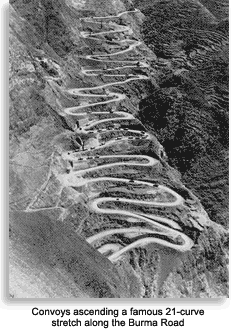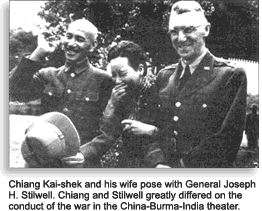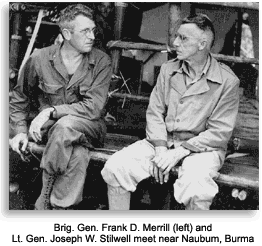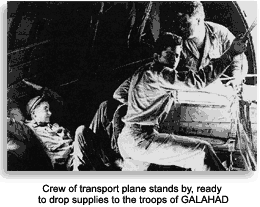The Allies' aim in the China-Burma-India (CBI) Theater of World War II was to supply and buttress Chinese armies in their struggle against a massive Japanese incursion. The enemy's seizure of China's seaports had severed its traditional supply lines. Accordingly, the Allies transported equipment, men and supplies to China through Burma by building roads and pipelines, and India by flying the "Hump" route over the Himalayas. In addition, the Allies aided China in the Japanese attack by conducting ground and air offensives.
By means of U.S. Combat Cargo Groups, flying the hump over the Himalayas from India became an important factor in the CBI supply strategy. Further, construction of the Burma and Ledo roads also were vital to CBI operations.
Pre-war
The Pearl Harbor Attack at the end of 1941 spurred America into World War II, but it was an earlier American commitment to China that drew the U.S. Army into the Burma Campaign of 1942. For some months prior to Pearl Harbor, the U.S. had been supporting China's war against Japan with money and matériel.
Japan had invaded China in 1937, gradually isolating it from the rest of the world except for two tenuous supply lines: A narrow-gauge railway originating in Haiphong, French Indochina; and the Burma Road, an improved highway linking Lashio in British Burma to Kunming in China. Those routes carried the material that made it possible for Chiang Kai-shek's Nationalist Chinese government to resist Japanese offensives.
 Burma Road closed
In late May 1942, Lt. General Joseph W. Stilwell, nicknamed "Vinegar Joe," told a group of reporters that his Allied force "got a hell of a beating." Stilwell, a career Army officer and veteran of World War I, had just been handed a sound defeat by Japanese forces operating in Burma. The American general had been in command for fewer than two months when his combined force of Chinese, British and Indian soldiers were forced out of Burma.
The Japanese destroyed the Burma Road, which was the only overland supply route stretching from northern India through Burma and into China. If the allies wanted to drive the Japanese 18th Division out of the area, Stilwell resolved that the important route must be reopened.
The Ledo Road was built from Ledo in Assam into the Hukawng Valley as an alternative to the Burma Road. It was completed in January 1945 and was renamed Stilwell Road by Chiang Kai-shek.
Flying the "Hump"
Before a large-scale ground assault into Burma could occur, it was first essential to send supplies to Chinese guerrilla forces already fighting the Japanese in Burma. That task fell to the U.S. 10th Air Force. Based in India, the 10th took responsibility for substantial air cargo flights and began operations over the hump in April 1942 — a dangerous 530-mile long passage over the peaks of the Himalayan Mountains.
In October 1942, General or the Air Force, Henry H. "Hap" Arnold decided to put the Air Transport Command (ATC) in command of all hump operations, and 10th Air Force units on hump assignments were transferred to the ATC in December. The ATC, with authority to handle all airlift requirements in the theater of operations, brought its special experience to sort out the problems in air transportation and cargo flying.
Pilots started flying the "Hump" in April 1942, in the face of poor weather, 15,000-foot peaks (requiring oxygen) and a swarm of Japanese fighter aircraft operating from a base at Myitkyina, Burma. By August 1943 plans to invade Burma were in full swing.
Chindits
In early 1943, a mixed "brigade" of British, Burmese, and Gurkhas conducted a daring, three-month raid into Burma. British Army Major General Orde Wingate had organized that brigade of raiders, known as the Chindits, to infiltrate by foot through Japanese lines in Burma and conduct hit-and-run attacks — relying on airdrops for supplies.
By February 1943, General Wingate had already lost two thirds of his men. However, the fact that he was able to infiltrate a superior Japanese force proved to be a valuable example of long-range penetrations for the Allies.
Burma Road closed
In late May 1942, Lt. General Joseph W. Stilwell, nicknamed "Vinegar Joe," told a group of reporters that his Allied force "got a hell of a beating." Stilwell, a career Army officer and veteran of World War I, had just been handed a sound defeat by Japanese forces operating in Burma. The American general had been in command for fewer than two months when his combined force of Chinese, British and Indian soldiers were forced out of Burma.
The Japanese destroyed the Burma Road, which was the only overland supply route stretching from northern India through Burma and into China. If the allies wanted to drive the Japanese 18th Division out of the area, Stilwell resolved that the important route must be reopened.
The Ledo Road was built from Ledo in Assam into the Hukawng Valley as an alternative to the Burma Road. It was completed in January 1945 and was renamed Stilwell Road by Chiang Kai-shek.
Flying the "Hump"
Before a large-scale ground assault into Burma could occur, it was first essential to send supplies to Chinese guerrilla forces already fighting the Japanese in Burma. That task fell to the U.S. 10th Air Force. Based in India, the 10th took responsibility for substantial air cargo flights and began operations over the hump in April 1942 — a dangerous 530-mile long passage over the peaks of the Himalayan Mountains.
In October 1942, General or the Air Force, Henry H. "Hap" Arnold decided to put the Air Transport Command (ATC) in command of all hump operations, and 10th Air Force units on hump assignments were transferred to the ATC in December. The ATC, with authority to handle all airlift requirements in the theater of operations, brought its special experience to sort out the problems in air transportation and cargo flying.
Pilots started flying the "Hump" in April 1942, in the face of poor weather, 15,000-foot peaks (requiring oxygen) and a swarm of Japanese fighter aircraft operating from a base at Myitkyina, Burma. By August 1943 plans to invade Burma were in full swing.
Chindits
In early 1943, a mixed "brigade" of British, Burmese, and Gurkhas conducted a daring, three-month raid into Burma. British Army Major General Orde Wingate had organized that brigade of raiders, known as the Chindits, to infiltrate by foot through Japanese lines in Burma and conduct hit-and-run attacks — relying on airdrops for supplies.
By February 1943, General Wingate had already lost two thirds of his men. However, the fact that he was able to infiltrate a superior Japanese force proved to be a valuable example of long-range penetrations for the Allies.
 Ground troops needed
There were no U.S. ground combat troops in the CBI Theater. Both the Chinese, under the leadership of Chiang Kai-shek (with whom Stilwell regularly had disagreements), and the British refused to commit large numbers of their soldiers to action in Burma. Disgruntled, Stilwell requested that American forces be sent to India — a call to perform "a dangerous and hazardous mission."
Second-generation Japanese-American (Nisei)linguists were attached as interpreters, and fought closely with British, Australian, and New Zealand troops, as well as units from India, China, and Burma.
A call for volunteers from existing Pacific Theater and stateside army units was issued. However, what Stilwell got were not well-trained fighters as he had anticipated. He received a cluster of "adventurers, small-town Midwestern farm boys, a few Native Americans and Japanese Americans and a great number of disciplinary cases that commanders were only too happy to unload."
Imphal
Imphal, capital of the small state of Manipur, covered some 700 square miles. The Imphal Plain was the site of some of the bloodiest fighting of World War II. Entrance to the plain from the north was along a winding road through the village of Kohima. The distance between the two towns was about 140 miles. The most vulnerable point on the road was where it crossed the summit of a 4,700-foot pass at Kohima. If the Japanese could seize the pass, Imphal would be completely cut off. If they could capture Dimapur to the north as well, they then could cut Stilwell’s supply line to Ledo and beyond.
On March 15th, 1944, the Japanese offensive began as Maj. General Masafumi Yamauchi’s 15th Division and Lt. General Kotoku Sato’s 31st Division poured across the Chindwin River by raft, ferry and boat. For Sato, the target was Kohima. He was expected to advance at least 20 miles a day, with 5,000 oxen following and some of his soldiers acting as porters. British Army General Slim and his troops resisted the enemy’s advance, inflicting more than 1,000 casualties. But as the strength of the Japanese thrust became evident, Slim decided to draw back all outposts and concentrate the troops in Kohima.
The Japanese cut all roads into the town and effectively isolated it, for there was no airstrip. The small garrison of 3,500 was pitted against 15,000 Japanese, who laid down a murderous barrage from the heights. The siege lasted 16 days. In the end, the Allies held on to that vital bridgehead to India.
Ground troops needed
There were no U.S. ground combat troops in the CBI Theater. Both the Chinese, under the leadership of Chiang Kai-shek (with whom Stilwell regularly had disagreements), and the British refused to commit large numbers of their soldiers to action in Burma. Disgruntled, Stilwell requested that American forces be sent to India — a call to perform "a dangerous and hazardous mission."
Second-generation Japanese-American (Nisei)linguists were attached as interpreters, and fought closely with British, Australian, and New Zealand troops, as well as units from India, China, and Burma.
A call for volunteers from existing Pacific Theater and stateside army units was issued. However, what Stilwell got were not well-trained fighters as he had anticipated. He received a cluster of "adventurers, small-town Midwestern farm boys, a few Native Americans and Japanese Americans and a great number of disciplinary cases that commanders were only too happy to unload."
Imphal
Imphal, capital of the small state of Manipur, covered some 700 square miles. The Imphal Plain was the site of some of the bloodiest fighting of World War II. Entrance to the plain from the north was along a winding road through the village of Kohima. The distance between the two towns was about 140 miles. The most vulnerable point on the road was where it crossed the summit of a 4,700-foot pass at Kohima. If the Japanese could seize the pass, Imphal would be completely cut off. If they could capture Dimapur to the north as well, they then could cut Stilwell’s supply line to Ledo and beyond.
On March 15th, 1944, the Japanese offensive began as Maj. General Masafumi Yamauchi’s 15th Division and Lt. General Kotoku Sato’s 31st Division poured across the Chindwin River by raft, ferry and boat. For Sato, the target was Kohima. He was expected to advance at least 20 miles a day, with 5,000 oxen following and some of his soldiers acting as porters. British Army General Slim and his troops resisted the enemy’s advance, inflicting more than 1,000 casualties. But as the strength of the Japanese thrust became evident, Slim decided to draw back all outposts and concentrate the troops in Kohima.
The Japanese cut all roads into the town and effectively isolated it, for there was no airstrip. The small garrison of 3,500 was pitted against 15,000 Japanese, who laid down a murderous barrage from the heights. The siege lasted 16 days. In the end, the Allies held on to that vital bridgehead to India.
 Merrill’s Marauders
Those 3,000 "misfits," as one Army officer put it, were sent to India, trained in jungle warfare and designated the 5307 Composite Unit, code name GALAHAD. Stilwell’s long-time friend, Brig. General Frank D. Merrill, was placed in command, and the unit was ready for action by early 1944.
Plans were drawn up for an offensive to begin with a Chinese-American force attacking North Burma, with the goal of taking Myitkyina, which would remove the threat of enemy fighter planes attacking allied forces flying the hump. Stilwell also planned to use Myitkyina as a bomber base for attacks on the Japanese homeland.
Accompanied by two Chinese divisions, GALAHAD (Merrill's Marauders), which was now split into three battalions, began its trek through the jungle-choked terrain of Northeast Burma on February 24, 1944. GALAHAD quickly struck Japanese outposts all along the Burma front, and by March 3, all battalions had reached the main Japanese line. After four days of harsh fighting, the dug-in Japanese retreated.
GALAHAD was reduced from its original 3,000 men to less than 1,400 and most of those soldiers were sick (jungle diseases), ill-equipped and tired. The men were now looking forward to promised relief and a long rest behind the lines. Stilwell had other ideas.
Assured by the British that the situation in Imphal was under control, Stilwell wanted to launch a final assault to capture Myitkyina. The remaining 1,400 Marauders would spearhead the operation.
On May 17th, 1944, after a grueling 65-mile march over the 6,000-foot Kumon Mountain range (using mules for carrying supplies) to Myitkyina, the Marauders, along with several Chinese regiments, attacked the unsuspecting Japanese at the Myitkyina airfield. Success for the Marauders at the airfield came quickly; however, the town of Myityina could not immediately be taken.
Merrill’s Marauders
Those 3,000 "misfits," as one Army officer put it, were sent to India, trained in jungle warfare and designated the 5307 Composite Unit, code name GALAHAD. Stilwell’s long-time friend, Brig. General Frank D. Merrill, was placed in command, and the unit was ready for action by early 1944.
Plans were drawn up for an offensive to begin with a Chinese-American force attacking North Burma, with the goal of taking Myitkyina, which would remove the threat of enemy fighter planes attacking allied forces flying the hump. Stilwell also planned to use Myitkyina as a bomber base for attacks on the Japanese homeland.
Accompanied by two Chinese divisions, GALAHAD (Merrill's Marauders), which was now split into three battalions, began its trek through the jungle-choked terrain of Northeast Burma on February 24, 1944. GALAHAD quickly struck Japanese outposts all along the Burma front, and by March 3, all battalions had reached the main Japanese line. After four days of harsh fighting, the dug-in Japanese retreated.
GALAHAD was reduced from its original 3,000 men to less than 1,400 and most of those soldiers were sick (jungle diseases), ill-equipped and tired. The men were now looking forward to promised relief and a long rest behind the lines. Stilwell had other ideas.
Assured by the British that the situation in Imphal was under control, Stilwell wanted to launch a final assault to capture Myitkyina. The remaining 1,400 Marauders would spearhead the operation.
On May 17th, 1944, after a grueling 65-mile march over the 6,000-foot Kumon Mountain range (using mules for carrying supplies) to Myitkyina, the Marauders, along with several Chinese regiments, attacked the unsuspecting Japanese at the Myitkyina airfield. Success for the Marauders at the airfield came quickly; however, the town of Myityina could not immediately be taken.
 On June 17th, near the Irrawaddy River north of Myitkyina, the Marauders successfully cut the Japanese supply line into the city. Two weeks later the besieged city fell to a Chinese attack. The war was over for GALAHAD. Despite constant battles with the Japanese, malaria, dysentery and scrub typhus, Merrill's Marauders, fought their way through 700 miles of Burmese jungle over seven months.
Burma victory
In August 1944, what was left of GALAHAD was consolidated with the 475th Infantry. Those men, along with members of the Texas National Guard, formed the Mars Task Force and continued operations deep into the Burmese jungle. A strong offensive began in early October, which gathered with members of the Mars Task Force reaching the Burma Road later that month.
In January of 1945, U.S. Army engineers reopened Burma Road. With the route finally open, Allied forces quickly routed the Japanese out of Burma and were able to successfully run supplies into mainland China.
On June 17th, near the Irrawaddy River north of Myitkyina, the Marauders successfully cut the Japanese supply line into the city. Two weeks later the besieged city fell to a Chinese attack. The war was over for GALAHAD. Despite constant battles with the Japanese, malaria, dysentery and scrub typhus, Merrill's Marauders, fought their way through 700 miles of Burmese jungle over seven months.
Burma victory
In August 1944, what was left of GALAHAD was consolidated with the 475th Infantry. Those men, along with members of the Texas National Guard, formed the Mars Task Force and continued operations deep into the Burmese jungle. A strong offensive began in early October, which gathered with members of the Mars Task Force reaching the Burma Road later that month.
In January of 1945, U.S. Army engineers reopened Burma Road. With the route finally open, Allied forces quickly routed the Japanese out of Burma and were able to successfully run supplies into mainland China.